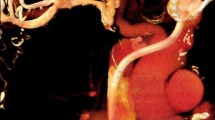Abstract
Purpose
To report the technical success and complications following sharp recanalization of chronic venous occlusions.
Materials and Methods
A total of 123 patients, including 75 (61.0%) men and 48 (39.0%) women, with mean age of 50.5 ± 17.5 years (range 19–90 years), underwent sharp recanalization of chronic venous occlusions. The etiologies of occlusion were chronic deep venous thrombosis (n = 43; 35.0%), prior central venous access (n = 39; 31.7%), indwelling cardiac leads (n = 21; 17.1%), and occluded venous stents (n = 20; 16.3%). The sites of venous occlusion included 59/123 (48.0%) thoracic central veins, 37 (30.1%) non-thoracic central veins, and 27 (22.0%) peripheral veins. Median length of occlusion was 3.2 ± 1.4 cm (range 1.3–10.9 cm).
Results
Sharp recanalization was most commonly attempted with transseptal needles in 108/123 (87.8%), with a mean number of 1.2 ± 0.4 crossing devices per patient (range 1–4 devices). Targeting devices included a loop snare (n = 92; 74.8%), partially deployed Wallstent (n = 21; 17.1%), partially deployed Amplatzer vascular plug (n = 8; 6.5%), and an angioplasty balloon (n = 3; 2.4%). Technical success was achieved in 111 (90.2%) patients. There were 3 (2.4%) severe, 1 (0.8%) moderate, and 7 (5.7%) minor adverse events. Severe adverse events included 1 case each of pericardial tamponade, hemothorax, and inferior vena cava filter occlusion. 88 (71.5%) patients had venous stents placed; at the last follow-up examination, 68/86 (79.0%) stents were patent.
Conclusion
Sharp recanalization has a high technical success and low rate of adverse events in the recanalization of chronic venous occlusions.


Similar content being viewed by others
References
Kundu S. Central venous obstruction management. Semin Intervent Radiol. 2009;26(2):115–21.
Lumsden AB, MacDonald MJ, et al. Central venous stenosis in the hemodialysis patient: incidence and efficacy of endovascular treatment. Cardiovasc Surg. 1997;5(5):504–9.
Allen AW, Megargell JL, et al. Venous thrombosis associated with the placement of peripherally inserted central catheters. J Vasc Interv Radiol. 2000;11(10):1309–14.
Raju S. Best management options for chronic iliac vein stenosis and occlusion. J Vasc Surg. 2013;57(4):1163–9.
Agarwal AK, Patel BM, Haddad NJ. Central vein stenosis: a nephrologist’s perspective. Semin Dial. 2007;20(1):53–62.
Cohen EI, Beck C, et al. Success rate and complications of sharp recanalization for treatment of central venous occlusions. Cardiovasc Interv Radiol. 2018;41(1):73–9.
Goo DE, Kim YJ, et al. Use of a Rösch-Uchida needle for recanalization of refractory dialysis-related central vein occlusion. Am J Roentgenol. 2010;194(5):1352–6.
Hanauer DA, Mei Q, et al. Supporting information retrieval from electronic health records: a report of University of Michigan’s nine-year experience in developing and using the Electronic Medical Record Search Engine (EMERSE). J Biomed Inform. 2015;55:290–300.
Dolmatch BL, Gurley JC, et al. Society of interventional radiology reporting standards for thoracic central vein obstruction. J Vasc Interv Radiol. 2018;29(4):454–60.
Williams DM. Iliocaval reconstruction in chronic deep vein thrombosis. Technol Vasc Interv Radiol. 2014;17(2):109–13.
Khaja MS, Chick JFB, et al. Fluoroscopic targeting of wallstents and amplatzer vascular plugs in sharp recanalization of chronic venous occlusions. Cardiovasc Interv Radiol. 2017;40(11):1777–83.
Chick JFB, Jo A, et al. Endovascular iliocaval stent reconstruction for inferior vena cava filter-associated iliocaval thrombosis: approach, technical success, safety, and two-year outcomes in 120 patients. J Vasc Interv Radiol. 2017;28(7):933–9.
Khalilzadeh O, Baerlocher MO, et al. Proposal of a new adverse event classification by the society of interventional radiology standards of practice committee. J Vasc Interv Radiol. 2017;28(10):1432.
Gupta H, Murphy TP, Soares GM. Use of a puncture needle for recanalization of an occluded right subclavian vein. Cardiovasc Interv Radiol. 1998;21(6):508–11.
Murphy TP, Webb MS. Percutaneous venous bypass for refractory dialysis-related subclavian vein occlusion. J Vasc Interv Radiol. 1998;9(6):935–9.
Miyayama S, Minami T, et al. Small needle puncture of a central venous occlusion in a hemodialysis patient that could not be traversed by a conventional technique. Cardiovasc Interv Ther. 2014;29(3):261–5.
Lang EV, Vrachliotis TG, Brophy DP. Sharp recanalization for chronic central venous occlusions. Tech Vasc Interv Radiol. 2000;3(1):21–8.
Ferral H, Bjarnason H, et al. Recanalization of occluded veins to provide access for central catheter placement. J Vasc Interv Radiol. 1996;7(5):681–5.
Beathard GA, Eradat J. Chronically occluded arteriovenous fistula salvaged by sharp needle recanalization. Semin Dial. 2015;28(6):E58–63.
Athreya S, Scott P, et al. Sharp recanalization of central venous occlusions: a useful technique for haemodialysis line insertion. Br J Radiol. 2009;82(974):105–8.
Honnef D, Wingen M, et al. Sharp central venous recanalization by means of a TIPS needle. Cardiovasc Interv Radiol. 2005;28(5):673–6.
Ito N, Isfort P, et al. Sharp recanalization for chronic left iliac vein occlusion. Cardiovasc Interv Radiol. 2012;35(4):938–41.
Guimaraes M, Schonholz C, et al. Radiofrequency wire for the recanalization of central vein occlusions that have failed conventional endovascular techniques. J Vasc Interv Radiol. 2012;23(8):1016–21.
Davis RM, David E, et al. Radiofrequency guide wire recanalization of venous occlusions in patients with malignant superior vena cava syndrome. Cardiovasc Interv Radiol. 2012;35(3):676–9.
Malik AK, Bhalla N, et al. Percutaneous reconstruction of chronic total occlusion of brachiocephalic vein using transseptal needle in dialysis-dependent patient. Cardiovasc Interv Ther. 2016;31(2):136–9.
Arabi M, Ahmed I, et al. Sharp central venous recanalization in hemodialysis patients: a single-institution experience. Cardiovasc Interv Radiol. 2016;39(6):927–34.
Porter D, Rundback JH, Miller S. Sharp recanalization using a subintimal reentry device, angioplasty, and stent placement for severely symptomatic iliofemoral deep venous thrombosis secondary to congenital aplasia of the inferior vena cava. J Vasc Interv Radiol. 2010;21(11):1765–9.
Author information
Authors and Affiliations
Corresponding author
Ethics declarations
Conflict of interest
The authors declare that they have no conflict of interest.
Ethical Approval
All procedures performed in studies involving human participants were in accordance with the ethical standards of the institutional and/or national research committee and with the 1964 Helsinki Declaration and its later amendments or comparable ethical standards.
Informed Consent
This study has obtained Institutional Review Board Approval, and the need for informed consent was waived.
Electronic supplementary material
Below is the link to the electronic supplementary material.
Rights and permissions
About this article
Cite this article
McDevitt, J.L., Srinivasa, R.N., Gemmete, J.J. et al. Approach, Technical Success, Complications, and Stent Patency of Sharp Recanalization for the Treatment of Chronic Venous Occlusive Disease: Experience in 123 Patients. Cardiovasc Intervent Radiol 42, 205–212 (2019). https://doi.org/10.1007/s00270-018-2090-1
Received:
Accepted:
Published:
Issue Date:
DOI: https://doi.org/10.1007/s00270-018-2090-1




